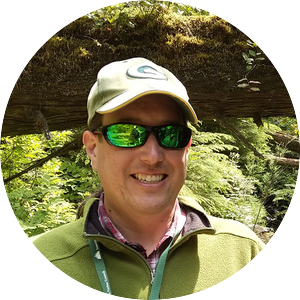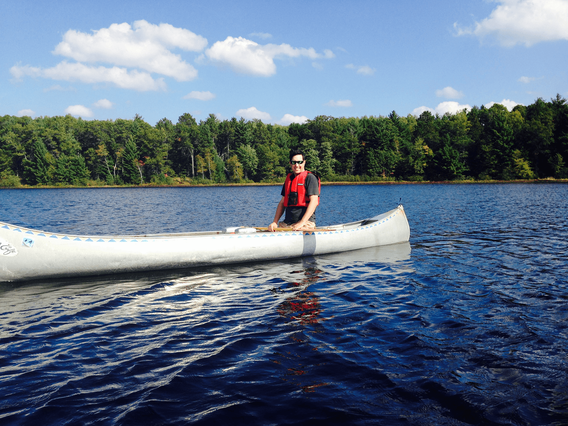Assistant Professor of Forestry
Dr. Mike Dockry is a registered member of the Citizen Potawatomi Nation and an Assistant Professor in the University of Minnesota’s Department of Forest Resources. He is also an associate faculty member of the American Indian Studies Department and an Institute on the Environment Fellow. He teaches Tribal and Indigenous Natural Resource Management and Traditional Ecological Knowledge and Western Natural Resource Management. Mike describes himself as a public servant, with a background in the U.S. Forest Service and the Peace Corps, and sees his research as service to help communities sustainably manage their natural resources. Through his teaching and research, he works to support tribal forestry and to support students—especially helping students understand tribes and treaty rights.
Mike says, “Natural resource professionals in the Midwest need to understand how to find information about tribes and treaty rights, and they need to know how to build partnerships with tribal natural resource managers.” We’re always improving our degree program here to prepare our graduates to establish those relationships and connect with tribal resource managers to better understand the social and cultural importance of forests and to achieve better management outcomes.
“I work on natural resource management issues that are important to tribes. While some scientists might study a particular species of tree or specific natural phenomena that dictates the focus of their service, I work with tribes to build partnerships to learn what research can best help them manage their own resources more sustainably.”
Mike is working with tribes in Minnesota to study wild rice management as part of a collaborative cross-disciplinary project called Kawe Gidaa-Naanaagadawendaamin Manoomin/Psin (first we must consider Manoomin). The researchers are investigating the changes over time in wild rice in the Midwest. They’ve observed a steady decline in health wild rice habitat from Michigan to Wisconsin to Minnesota, and they intend to identify the pieces in the system—both ecological and social—that are contributing to that decline.
“We got a large grant from the National Science Foundation to continue our work with wild rice, and I’m really excited about it because it’s a project led by the tribes. We have skills and resources at the university that we can provide to them to help achieve their goals, which are to protect and restore wild rice across the region. We have interdisciplinary faculty from multiple colleges working together on this project, as well as graduate students, post-docs, and undergraduate researchers. We’re providing money directly to the tribes to move the research forward and purchase equipment. We have money for their salaries, which is so important. We always put money for our own salaries in grants, and since this is an equal partnership, I’m proud that we got funding for their natural resource managers salaries and some internships.”
Mike feels that building partnerships with tribes is critical for doing the work of natural resources management, particularly in the Great Lakes region where we have a large number of tribes; treaty resources; and public, private, and tribal land mixed together. “We need those partnerships to manage across landscapes like we know we should be doing.” There are legal, moral, ethical, and ecological reasons for building partnerships with tribes, yet agencies, NGOs and universities are always asking, “How do we do that?” because it’s something that hasn’t really happened in the past, or at least not systematically. Mike’s research focuses on breaking down barriers and finding best practices for establishing connections. He conducts case studies and interviews to build theories around what creates meaningful participation and to develop guidelines for getting there.
“Formal and informal agreements are important, and building relationships and actually becoming friends is super important. Walking the land and canoeing the water together to build a mutual understanding of each other and of the land, in place and in context, is really productive. I focus on the tribes, but I think all of the research that I do is equally applicable to building partnerships and relationships with anybody. It’s tremendously valuable for native and nonnative students alike to get experience working with tribes, and I’m hopeful that experience will help achieve diversity goals both in university settings and in the forestry profession at large.”
Mike also focuses research on institutional diversity and inclusion in the natural resource management profession and its institutions. He conducts studies that track personnel demographics over time in federal agencies to understand how well our federal agencies are representing the population of our country.
“We know that if workforces don’t represent the country—not just along gender, race, and ethnicity, but also with values—those agencies across the board are going to become irrelevant. If the Forest Service, for example, needs to do some environmental restoration projects, but they don’t have voices from the majority of the people, or they only have one perspective represented, then they won’t have community support. You need to have the public behind you as a public agency. You need that social license to operate.”
In the coming year, Mike will be exploring incorporating tribal perspectives and the concept of traditional ecological knowledge into our natural resource management practices. He makes the case from his partnership work that we can’t access that wisdom unless we have strong relationships with the tribes who hold that knowledge. He’ll be creating spaces for dialog that allow traditional knowledge to dictate, inform, support, and improve our sustainability in natural resource management. The tribes hold a great deal of knowledge on how fire can create balance within an ecosystem and support sustainability, and that knowledge is not limited to the American West. More and more people are thinking about fire out East and here in the Great Lakes region, as well.
“The fire knowledge that tribes have has really influenced fire and forest management in the American West. We’ve seen that unsustainable suppression of fire, combined with climate change and invasive insects, has really caused problems on our landscapes. What we find is that incorporating traditional ecological knowledge and perspectives helps make better research and gives us new directions to explore in terms of what we’re doing on the land.”
Research can tell us a great deal about the world around us, but it can also look forward to tell us about the world ahead of us. A major tenant of Mike’s research is on planning and strategic foresight. It started as a professional concept in the 1940s primarily in the US military and private industry as an approach to understanding uncertainty and complexity.
“The whole premise is to think about the future as futures so you can prepare for multiple outcomes. If you can imagine different things happening, then you can get ready for those things. If you don’t imagine something ahead of time, it’s going to take you totally by surprise and you’re going to struggle in reacting to it. Our idea is to get these techniques into the public sphere because they’re still kind of hidden in the military and Fortune 500 companies.”
This approach is important for considering problems like climate change. Even though we have lots of excellent climate models, there’s still quite a bit of uncertainty on what exactly is going to happen, how it’s going to come about, and the speed and timing of it. Strategic foresight can help make actual climate change management decisions on the ground at the local level. “I get people with different backgrounds and perspectives into a room and ask them, What does it mean to you if the ice goes out earlier and earlier every year?”
These conversations also enable us to bring together people with a wide range of perspectives and background who live in the same community but might not talk to each other on a regular basis. Mike’s research programs can present a scenario to public health officials, engineers, public works, facilities management, forestry and natural resources, educators, and interested community members in the search of better answers to big questions that might not seem pressing enough to consider in the moment.
“People in these groups will often say, 'I actually never talk to that office. We know climate change is an important problem for public health, but we’ve never actually sat down and talked it over with the nurses.' We really do need to talk to each other about this because climate change impacts every single facet of our lives from mental health to physical health to plowing the streets.”
This approach can engage people together across ideological lines without appealing to a specific kind of authority or expertise. Skeptics are able to engage in futurist thinking just the same because the premise starts from Is this possible? rather than Is this true? and many things are possible once you’re able to suspend your disbelief. They can still engage in a discussion about something they don’t agree with or don’t believe in because it might still be possible or at least not impossible.
“At the very least, we can approach it like an asteroid hitting the earth and blocking out the sun—also possible, regardless of whether it’s particularly likely or not. I could still engage in a discussion around what it would mean if it were to happen, how it would impact me, and how I would react to it. Facilitating a dialogue, if nothing else, builds community. Maybe the asteroid isn’t going to hit, but the fact that we got together and talked about it will help us deal with whatever does happen in the future.”
“We’re moving forward and forestry has a big role to play in that because anything we can make with petroleum we can theoretically make with cellulose. If we get to a place where every twig and leaf can be turned into iPads, that’s going to put huge pressure on our forest resources that we haven’t seen in a while; however, you can consider whether that’s more sustainable to grow and harvest something over and over instead of pumping carbon stored in the earth or mining precious metals. Another future vision is a completely compostable cell phone, which seems far-fetched now, but it’s not impossible.”
Forestry is such an accessible field because we can see trees and go out and touch them, but we can’t really see them move. To perceive the movement of a forest is beyond the scope of our bodies. We need help, otherwise it’s really easy to look at a forest as a bunch of wood. People and forests are on different temporal tracks. “I think forestry is awesome in this regard because it’s very practical and future-oriented by definition. Trees live a long time. You’re thinking 50-100 years into the future. With forestry, I know that I have a park that I visit and I can see how they’re managing those trees. I want to be managing their parks, forests, and natural lands in a way that supports that community. Our research has to be practical, by necessity, and I really do love that about forestry in the university. We do groundbreaking research and develop new technologies to help us, but the bottom line is we’re talking about real things out in the world that impact everybody.”
Image 1 description: Mike Dockry, a Native American man in a green fleece with a hat and sunglasses standing in front of a green forest.
Image 2 description: Mike Dockry, a Native American man wearing an orange life jacket canoeing on a calm lake.


